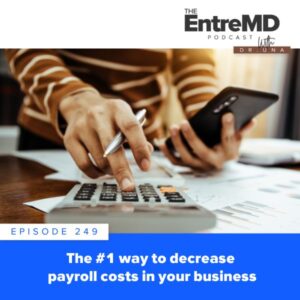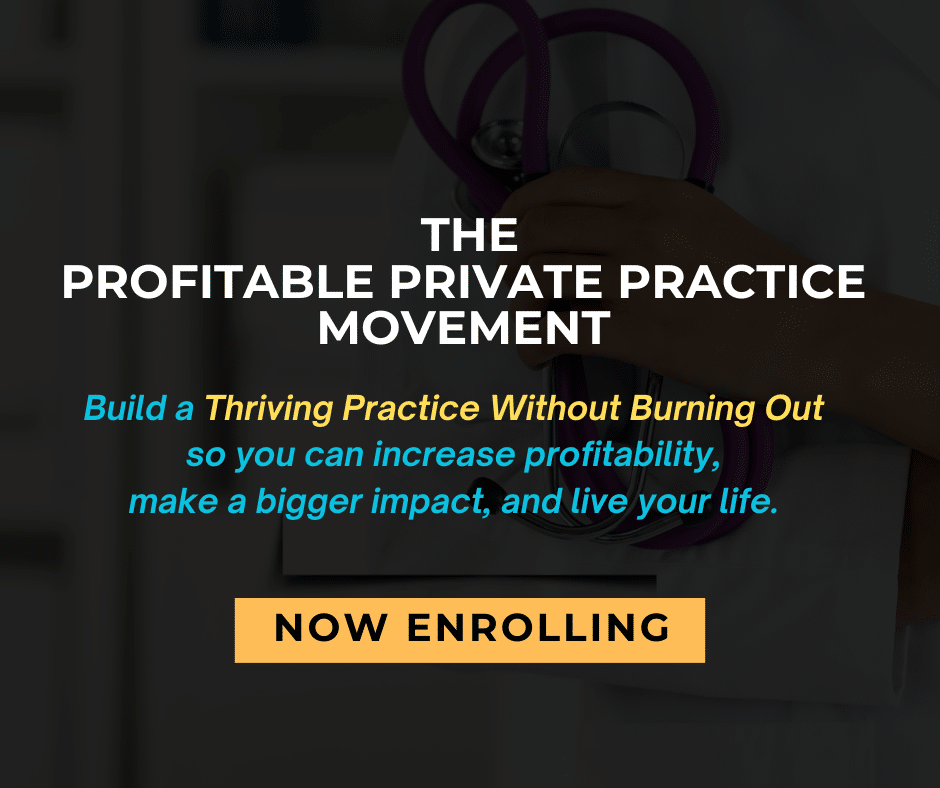 Payroll is one of the highest expenses a business can have. However, it’s also some of the most important money we spend in our business. So, when it comes to reducing payroll costs, what’s the best way to approach doing this in your business, whether that’s a private practice, a personal brand, or anything else?
Payroll is one of the highest expenses a business can have. However, it’s also some of the most important money we spend in our business. So, when it comes to reducing payroll costs, what’s the best way to approach doing this in your business, whether that’s a private practice, a personal brand, or anything else?
In private practice, payroll can easily be hundreds of thousands of dollars per year. But it doesn’t have to be considered a sunk cost you have to pay that you’ll never see again. Your payroll costs are actually an investment, and in this week’s episode, I’m sharing some advice that has the power to transform any business.
Tune in this week to discover the number one way to reduce payroll costs in your business. I’m showing you how to totally reframe the way you think about the money you spend on payroll, and how to make sure your payroll is spent on turning all areas of your business and every role you fill into a profit center.
On August 22, 2022, I will be launching a 4-day video workshop on how to use video to leverage your brand and feel comfortable showing up on camera. Click here to join me.
The EntreMD Business School doors are finally open! If you’re ready to build a business that lets you live life and practice medicine on your own terms, click here to submit your application! And if you have questions, send us an email.
What You’ll Learn from this Episode:
- Why we always want to reduce costs but increase investment in our business.
- What changes when you think of your payroll costs as an investment.
- The importance of making sure every role in your business is generating its own revenue.
- What you can do to get clear on the potential profit every area of your business can generate.
- How to start treating your payroll as an investment instead of an expense.
Listen to the Full Episode:
Featured on the Show:
- I invite you to join my signature subscription program EntreMD On Demand, giving you access to a library of business courses designed to help you thrive as a physician entrepreneur!
- Email me
- YouTube Channel
- EntreMD Business School Testimonials
- The EntreMD Method: A Proven Roadmap for Doctors Who Want to Live Life and Practice Medicine on Their Terms by Nneka Unachukwu, MD.
Full Episode Transcript:
Hi docs, welcome to The EntreMD Podcast, where it’s all about helping amazing physicians just like you embrace entrepreneurship so you can have the freedom to live life and practice medicine on your terms. I’m your host, Dr. Una.
Well, hello, hello, my friends. Welcome back to another episode of The EntreMD Podcast. Thank you so much for coming back and listening, and reviewing, and sharing, and talking about this. I am so excited.
At the time of this recording we are at 287,000 downloads, which is such a significant number for me, because EntreMD is a movement and our job is to help physicians embrace entrepreneurship, right? It’s so we can get back control, so we can live life on our terms, so we can practice medicine on our terms.
And every time our numbers go up, I find out we have new listeners, I have hundreds of people listening to episode one, it’s just a reminder to me that we are getting the job done. Okay? I was looking at some data I saw randomly, someone was tweeting about it. And the percentage of physicians who are employed has risen to 73%.
And when I looked at that, and nothing wrong with employment, nothing at all. It’s just that in our context there’s not a lot of intrapreneurship with employment, there’s not a lot of leadership opportunities, there’s not a lot of control, there’s a whole lot of burnout and things like that. And it just reminded me of how important the work we’re doing is.
And I do want to say for everyone out there who’s doing the work, you are an intrapreneur. You started embracing speaking, you starting embracing negotiation, embracing being a leader in the workplace at your job, being the CEO of you incorporated at your job. I just want to give a big shout out to you.
And listen, you have stories you want to share with me, I want to share your stories, okay? So druna@entremd.com, so that’s D-R-U-N-A @entremd.com. I would love to hear it, I would love to share it. You are the cavalry we’ve been looking for. You are the change in medicine. You are the shining example of what is possible and people need to hear about it.
So just some of my musings, but I’m grateful that we’re doing this work. I’m grateful for your support. I’m grateful that you’re a part of the cavalry, you’re sharing, you’re telling other people about it. And we’re going to have a very shareable episode together right now. Right? Okay.
So we’re going to be looking at the number one way to decrease your payroll costs, okay? And I think this is really important because it is one of the highest expenses, costs in a business. And it can be one of the best things you do though, right? And so we’re going to take a look at that.
Like private practices, you’re talking hundreds and hundreds of thousands of dollars, right? And so how do you decrease that? Now, the first place we’re going to start from is this, what you pay in payroll can be an expense or a cost, right? It can be that, or it can be an investment. Okay?
Now, the thing about costs is that we want to decrease costs. The thing about investments is when we make them, it may hurt a little but we’re happy we did, right? So think about investing in real estate, especially if it’s something like a syndication, you know, it’s almost completely passive. So you invest in real estate and all of that.
Yeah, does pinch a little bit maybe, when you sign the check to send the money off to your investment. But there’s also this excitement, right? Like, oh, my goodness, look at what I just did. Okay, so what if your payroll could go from a cost to an investment? From an expense to an investment. That’s what we’re going to be looking at today.
So the number one way is not really by cutting staff or here’s where you can get people who can work for much lower or anything like that. It’s shifting, it’s reframing. It’s looking at your payroll cost and setting up your payroll differently so that it goes from cost status to investment status.
And the overarching concept here is making your employees profit centers, okay? Making every role a profit center. If you make the roles profit centers, then you can set it up where for every role, that role is generating its own revenue so then it doesn’t matter, right? Like your payroll is no longer a cost now, it’s an investment and you have a return on your investment. So let me break this down to you, okay?
In your business, I want you to think about it now, in your business think about the roles that you do have that you hire for. And so if you’re a private practice maybe you have a medical assistant, you have a front desk person, you have a manager, you have the doctors, all of those kind of things. If you’re a coach, maybe have other coaches who are working with you, maybe you have a sales team, maybe you have social sellers, all of those kinds of things, right? So just, think in those terms, so that’s what you have.
What if every role was profitable by itself? Like every role is a profit center. And I want to stop because I know we’re talking to doctors and we’ve been conditioned a certain way with money. So you may be saying, but I don’t lead with profit, it’s not all about profit.
Of course it’s not all about profit, right? We talk about serving and earning in the EntreMD world, it starts with serving, okay? So of course serving leads, but you cannot run a business without profit, right? So if there’s no profit, the business has to close down and the serving goes away.
So if you love serving people, you must also love making a profit because your profit is what allows you to continue to serve people, okay? All right. And you may be thinking, well, I’m an employee and I don’t like being thought of as a profit center. Right? Now, you are not a profit center, the role is a profit center, right?
But this is the way it works, okay? One of the best habits you can acquire is the habit of creating win-win situations, okay? Whenever there are two people involved in any kind of deal, you want to make sure that the person is getting a win, and you are getting a win. In biology we call that a symbiotic relationship, right?
If only one person is winning, that is a parasitic relationship. And you don’t want any business relationships or business deals that are parasitic. So when you think about a role, okay, so again, let’s say we’re using a medical assistant or we’re using a front desk for a private practice, or a coach, think of any of those roles. The revenue generated by that role should fall into three buckets, okay?
So it should generate the person’s salary, right? The person running that role, their salary. It should generate the overhead that it created in a way. And it should generate profit. Okay? And this is a true win-win situation because the salary, that is the staff reward, right? That’s the reward for the person running the role.
The overhead is the cost of business, okay? So that needs to be covered. And the profit is the owner’s reward, right? Because the owner took the risk, started the business, set up the stage for the job to be created and all of that. So that’s work as well, right? And that should be rewarded as well.
And so when you think about it, you want everybody to be rewarded, right? As a staff you want to be paid well, you want to be paid for what you did, right? And then you want the owner to also generate a profit, right? And so you’re a business owner, you want your people to earn money, and then you want to have a profit. No profit, business goes away, the end, right?
And so if you think about it, those are those three buckets. If every role was creating those three buckets then there’s no such thing as a payroll cost, it’s a payroll investment. And there is a return on the investment. Do you see what I’m saying? So it’s a different way of thinking about it. But then it makes you comfortable signing those really big checks for payroll.
Okay, so let’s play around with this a little bit with some examples, right? So let’s say you are in private practice and you have a medical assistant. So what does this look like? Well, this looks like when the person takes the patients back, and let’s say there are standard procedures that must be done for every patient with that kind of visit. When those procedures are not done, one is that it’s bad medicine. And two is that it’s bad business.
And so are we talking about manufacturing procedures that are not needed? No, right? But there are things that need to be done for certain patient types. And so sometimes they don’t get done, sometimes they get done but they are not billed for. It is billions of dollars that are left on the table for unbilled things. They’re not billed for, and that is throwing away, like literally opening the window, opening up your bank account and just throwing all the money out. That’s what that is, right?
And so if they are capturing all your revenue and all the revenue opportunities, then they’re being profitable. If the MA is making sure that everyone who comes is leaving with an appointment, they are being profitable.
So for instance, if you see 20 patients a day and out of the 20 they schedule 20 appointments, okay? Which usually doesn’t happen, but let’s say they schedule 16 appointments. Okay, so they scheduled 80% of the patients. And for the sake of the easy math, let’s say that for each one of those patient visits that were scheduled, that it is worth $200, right? That means that they generated $3,200. $3,200 in one day, right?
If you think about that, that means that that person, even though it’s not a lot of cha-ching in the medical office, but if you think about it, if they do 32,000 four days a week, that comes to $51,000 a month. And I paused so you can think about that, right?
If they did that every single month, that means every other month they’re bringing in 100,000. Your MA becomes a profit center and your MA pays for herself, pays for the overhead associated with her job and her work and all of those things, and generates a profit, right?
Same thing with the front desk. When I train people when I do consulting for private practices and we’re trying to turn things around, I’m like, “Think about your front desk as a salesperson.” Again, we don’t use those terms because it’s almost like a cuss word in medicine, but we’re changing that. Because when we don’t train our front desk to realize that a huge part of their job is to capture appointments, then people will call and say, “Hey, I want to make an appointment,” and they’ll say we’re booked.
And I cannot tell you how many doctors are so frustrated. They’re like my schedule is not full, I heard overheard my front desk person say we’re booked, we can’t see any more people. That’s because they’re not trained to be profit centers. They don’t realize how many appointments it takes to break even, how many appointments we want to see ideally, and all of that. They don’t quite see it that way.
But what if you trained them as a profit center? Again, we go back to the same thing. What if, based on people who call in or people who call in for questions that should really be appointments, what if out of the hundreds of phone calls that they answer every day, they are able to schedule 20 patients?
If they schedule 20 patients a day, that’s $4,000. If they do that four days a week, that’s $16,000. If they do that four weeks in a month, that’s $64,000 And in a year it’s $768,000. It covers their paycheck, it covers the overhead, and it generates a profit, right? And so if you think about it that way, the payroll is no longer a cost. It’s an investment, right?
So it’s a tiny shift, because there are none of these things that an MA doesn’t already do, or a front desk person doesn’t already do. But it may be viewed as some extra thing, it may be viewed as some annoying thing that I need to do. It may be viewed as a bother. It may not be on their KPIs at all.
Does your front desk person know how many people you want on your schedule? Is your front desk person rewarded for filling up your schedule? So think about it in those terms.
Well, what if you’re a coach and you have another coach working with you? And there are ways to do it, for instance if they’re working with other people, do they also have the responsibility of driving renewals, right? So they’re already working with people, say you work with people for six months. But you and I know people can need help for years really.
And this is not about selling people things they don’t need, but hey, you’re getting a lot of results. This is where we are, and we can go on for another six months or whatever. Do they drive renewals, right? Because if they drive renewals, again, they’re profit centers, right?
Some coaches are set up such that they can run their own informational sessions to get people to sign up. They would do it with affiliates and all of those kinds of things. But if you had your coaches doing that, and they were bringing in one, two, three, four clients a month, then they’re profit centers, right? And so you can bring on a coach to support your clients and it’s not a payroll expense or a cost, it is a payroll investment. And so there are ways to do it. There are ways to do it.
With your sales team it’s kind of like, you know, they’re the sales team so it’s easy to do that. But with all these other roles, there are ways to make them profit centers, to make it where their work, day to day, directly impacts the bottom line.
Now, the only kind of exception maybe to this would be someone who is in a purely administrative role. And with these ones, I usually say you’re probably ending up with one, right? Everybody else should be a profit center. And so that may be the person who manages your personal email, manages your calendar, maybe schedule some social media, and all of those kinds of things, does some customer service.
But there is still a way to build it in, right? And this is a role that you can actually allow to be a non-revenue generating role as long as you are clear that what this person does is they take all these administrative things off my plate, as the owner, to free me up to do high-level revenue generating activities.
And so what that means is, for instance, you may bring on an administrative person as a coach. All right, then you now have to look, what are the things that directly impact the bottom line for my business? It could be hosting workshops, it could be doing joint venture, lives, podcasts and things like that. It could be running info sessions. It could be doing sales calls and consults and things like that.
So what your admin person’s cost is to set you free of working the calendar when you can be talking to somebody who might work with you, right? And so you want to look at it in that way, that person is freeing me up so I could build more RGA, that’s revenue generating activity, RGA time into my business, right?
So in that way the admin is still an investment. Do you see what I mean? And so your admin may be such that your admin can only do admin stuff, but it’s still a profit center because she or he up-leveled your ability to be a profit center.
So that’s kind of the way to think about it. The more people you have on your team who are non-revenue generators, the more at risk your business is, right? Then you have a payroll cost, you have an expense, and it just sucks to pay it, right?
And so start thinking in these kinds of terms, how do I convert, so this is your homework. How do I convert the roles in my company to profit centers? How do I convert them to profit centers? And you don’t have to be overwhelmed by every single one if you have a lot of team members, but you start, right? Because you remember, I talk about this quote a lot that I hear from my husband, if you don’t start from where you are, you’ll stay where you are.
So maybe today you’re just picking, I never even thought about thinking of my front desk, letting them know how many appointments I need and all of those kinds of things. I’ve never thought about that. So it’s not a thing, we’re conscious of, it’s not a thing we even measure, right? And so maybe that’s where you start.
Maybe you’re a coach and you’re like, I never thought about that and renewals and like, yeah. And so they can get appointments on their calendar and talk to people about renewals. And so it changes your business.
And the thing is this, right, for your business to afford a team, it needs to make money. The end. It needs to make money. And so you figure out how to do that, then you can have a team, you’re okay with your team, you guys are doing great work together, they’re happy they get a good salary, you’re happy you get a profit, overhead is covered, business can live on and continue to serve a lot of people. Okay?
All right. So, you know my philosophy, business is math, this is not an emotional thing. This is just the way business works. And if you want to serve people in a container of business, this really is the way to think about it, okay?
So that’s your homework, go look in your business, go look at those roles, start making the adjustments because you can love writing those payroll checks, right? Knowing that it gives you the opportunity to serve more people, and it gives you the opportunity to build a better company, and it gives you longevity. And it is the way forward. Imagine loving to sign those checks. That could be your reality. Okay?
All right. So, I want you to do me a solid and take this episode and share it with the doctors in your life, okay? You know we did not get a business education and we call The EntreMD Podcast your free MBA, right? And this right here will save a lot of businesses. This right here will multiply the productivity and the profitability of many businesses.
This right here will help a lot of doctors go from solopreneur or not owning a productive, efficient team to building a company, like building an organization that can run, that knows how to work its money, its profits and all of that. And you could be the reason why that’s happening because you share this episode with them. So share the episode, and I will see you on the next episode of The EntreMD Podcast.
Hey, if you love listening to The EntreMD Podcast I want to invite you to join EntreMD On Demand. It is my signature subscription program that gives you access to a library of business courses designed to help you do one thing as a physician entrepreneur, and that is to thrive. Just head out to entremd.com/ondemand and I’d love to have you join us. See you on the inside.
Enjoy the Show?
- Don’t miss an episode, follow the podcast on Spotify and subscribe via Apple Podcasts or Stitcher.
- Leave me a review in Apple Podcasts.










